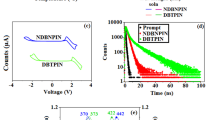Abstract
A new anthracene derivative 9,10-bis[3,5-di(4-tert-butylphenyl)phenyl]anthracene (BPPA) was synthesized via Suzuki coupling reaction and characterized by 1H NMR spectrum, mass spectrum, and elemental analysis. BPPA exhibits deep-blue emission both in solution and in solid thin film. This compound has a non-planar structure that results in high thermal stability and the phenomenon of polymorphism. The non-doped device based on this material shows stable deep-blue emission with the 1931 Commission international de I’Eclairage (CIE) coordinate of (0.15, 0.05) under different applied voltages. The device exhibits the maximum external quantum efficiency of 2.2% at 14.9 mA/cm2 with luminance of 105 cd/m2.
Similar content being viewed by others
References
Tang CW, Vanslyke SA. Organic electroluminescence diode. Appl Phys Lett, 1987, 51: 913–915
Burroughes JH, Bradley DDC, Broun AR, Marks RN, Mackay K, Friend RH, Burn PL, Holmes AB. Light-emitting diodes based on conjugated polymers. Nature, 1990, 347: 539–541
Tang CW, Vanslyke SA, Chen CH. Electroluminescence of doped organic thin films. J Appl Phys, 1989, 65: 3610–3616
Shi J, Tang CW. Doped organic electroluminescent devices with improved stability. Appl Phys Lett, 1997, 70: 1665–1667
Baldo MA, O’Brien DF, You Y, Shoustikov A, Sibley S, Thompson ME, Forrest SR. Highly efficient phosphorescent emission from organic electroluminescent devices. Nature, 1998, 395: 151–154
Sun Y, Giebink NC, Kanno H, Ma B, Thompson ME, Forrest SR. Management of singlet and triplet excitons for efficient white organic light-emitting devices. Nature, 2006, 440: 908–912
Zheng CJ, Zhao WM, Wang ZQ, Huang D, Ye J, Zhang XH, Lee CS, Lee ST. Highly efficient non-doped deep-blue organic light-emitting diodes based on anthracene derivatives. J Mater Chem, 2010, 20: 1560–1566
Wang L, Jiang Y, Wang J, Pei J, Cao Y. Highly efficient and colorstable deep-blue organic light-emitting diodes based on a solutionprocessible dendrimer. Adv Mater, 2009, 21: 4854–4858
Chien CH, Chen CK, Hsu FM, Shu CF, Chou PT, Lai CH. Multifunctional deep-Blue emitter comprising an anthracene core and terminal triphenylphosphine oxide groups. Adv Funct Mater, 2009, 19: 560–566
Shih PI., Chuang CY, Chien CH, Shu CF.. Highly efficient nondoped blue-light-emitting diodes based on an anthrancene derivative end-capped with tetraphenylethylene groups. Adv Funct Mater, 2007, 17: 3141–3146
Gao Q, Li ZH, Xia PF, Wong MS. Efficient deep-blue organic lightemitting diodes: Arylamine-substituted oligofluorenes. Adv Funct Mater, 2007, 17: 3194–3199
Moorhy JN, Venkatakrishnan P, Huang DF, Chow TJ. Blue lightemitting and hole-transporting amorphous molecular materials based on diarylaminobiphenyl-functionalized bimesitylenes. Chem Commun, 2008, 2146-2148
Zhen CG, Chen ZK, Liu QD, Kieffer J. Fluorene-based oligomers for highly efficient and stable organic blue-light-emitting diodes. Adv Mater, 2009, 21: 2425–2429
Liao SH, Shiu JR, Liu SW, Yeh SJ, Chen YH, Chen CT, Chow TJ, Wu CI. Hydroxynaphthyridine-derived group III metal chelates: Wide band gap and deep blue analogues of green Alq3 (tri(8-hydroxyquinolate) aluminum) and their versatile applications for organic light-emitting diodes. J Am Chem Soc, 2009, 131: 763–777
Kim YH, Shin DC, Kim SH, Ko CH, Yu HS, Kown SK. Novel blue emitting material with high color purity. Adv Mater, 2001, 13: 1690–1693
Wu CC, Lin YT, Wong KT, Chen RT, Chien YY. Efficient organic blue-light-emitting devices with double confinement on terfluorenes with ambipolar carrier transport properties. Adv Mater, 2004, 16: 61–65
Tang S, Liu MR, Lu P, Xia H, Li M, Xie ZQ, Shen FZ, Gu C, Wang HP, Yang B, Ma YG. A molecular glass for deep-blue organic lightemitting diodes comprising a 9,9′-spriobifluorene core and peripheral carbazole groups. Adv Funct Mater, 2007, 17: 2869–2877
Tao SL, Hong ZR, Peng ZK, Ju WG, Zhang XH, Wang PF, Wu SK, Lee ST. Anthracene derivative for a non-doped blue-emitting organic electroluminescence device with both excellent color purity and high efficiency. Chem Phys Lett, 2004, 397: 1–4
Kim YH, Jeong HC, Kim SH, Yang K, Kown SK. High-purity-blue and high efficiency electroluminescent devices based on anthracene. Adv Funct Mater, 2005, 15: 1799–1805
Kim SK, Yang B, Ma YG, Lee JH, Park JW. Exceedingly efficient deep-blue electroluminescence from new anthracenes obtained using rational molecular design. J Mater Chem, 2008, 18: 3376–3384
Frisch MJ, Trucks GW, Schlegel HB, Scuseria GE, Robb MA, Cheeseman JR. Gaussian 03, Revision A1, Gaussian Inc, Pittsburgh, PA 2003
Lee SJ, Park JS, Yoon KJ, Kim YI, Jin SH, Kang SK. High-efficiency deep-blue light-emitting diodes based on phenylquinoline/caybazolebased compounds. Adv Funct Mater, 2008, 18: 3922–3930
Wang ZQ, Xu C, Wang WZ, Fu WJ, Niu LB, Ji BM. Highly efficient undoped deep-blue electroluminescent device based on a novel pyrene derivative. Solid-State Electron, 2010, 54: 524–526
Liu F, Tang C, Chen QQ, Li SZ, Wu HB, Xie LH. Pyrene functioned diarylfluorenes as efficient solution processable light emitting molecular glass. Org Electron, 2009, 10: 256–265
K. Danel, T. H. Huang, J. T. Lin, Y. T. Tao, C. H. Chuen. Blueemitting anthracenes with end-capping diarylamines. Chem Mater, 2002, 14: 3860–3865
Shirota Y. Organic materials for electronic and optoelectronic devices. J Mater Chem, 2000, 10: 1–25
Author information
Authors and Affiliations
Corresponding author
Rights and permissions
About this article
Cite this article
Wang, Z., Zheng, C., Liu, H. et al. Efficient and stable non-doped deep-blue organic light emitting diode based on an anthracene derivative. Sci. China Chem. 54, 666–670 (2011). https://doi.org/10.1007/s11426-011-4243-9
Received:
Accepted:
Published:
Issue Date:
DOI: https://doi.org/10.1007/s11426-011-4243-9




